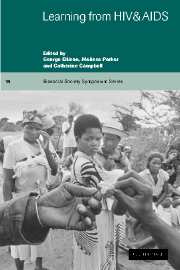Book contents
- Frontmatter
- Contents
- List of contributors
- Foreword by D. Clarke-Patel
- 1 Introduction. Learning from HIV and AIDS: from multidisciplinary to interdisciplinarity
- 2 HIV and the evolution of infectious diseases
- 3 The epidemiology of HIV/AIDS: contributions to infectious disease epidemiology
- 4 The influence of HIV/AIDS on demography and demographic research
- 5 What have clinicians learnt from working with HIV/AIDS? A medical perspective from London
- 6 How has the HIV/AIDS pandemic contributed to our understanding of behaviour change and health promotion?
- 7 Anthropological reflections on HIV prevention strategies: the case for targeting London's backrooms
- 8 An absence of anthropology: critical reflections on anthropology and AIDS policy and practice in Africa
- 9 A disaster with no name: the HIV/AIDS pandemic and the limits of governance
- 10 Postscript: reflections on HIV/AIDS and history
- Country index
- Subject index
- References
7 - Anthropological reflections on HIV prevention strategies: the case for targeting London's backrooms
Published online by Cambridge University Press: 14 January 2010
- Frontmatter
- Contents
- List of contributors
- Foreword by D. Clarke-Patel
- 1 Introduction. Learning from HIV and AIDS: from multidisciplinary to interdisciplinarity
- 2 HIV and the evolution of infectious diseases
- 3 The epidemiology of HIV/AIDS: contributions to infectious disease epidemiology
- 4 The influence of HIV/AIDS on demography and demographic research
- 5 What have clinicians learnt from working with HIV/AIDS? A medical perspective from London
- 6 How has the HIV/AIDS pandemic contributed to our understanding of behaviour change and health promotion?
- 7 Anthropological reflections on HIV prevention strategies: the case for targeting London's backrooms
- 8 An absence of anthropology: critical reflections on anthropology and AIDS policy and practice in Africa
- 9 A disaster with no name: the HIV/AIDS pandemic and the limits of governance
- 10 Postscript: reflections on HIV/AIDS and history
- Country index
- Subject index
- References
Summary
Introduction
Eight years ago the anthropologist Ralph Bolton (1995: 289) wrote: ‘Prevention efforts have enjoyed limited success – behaviours have changed to some degree in some places, but no thanks to our research’. Unfortunately, these words still hold true today. This chapter explores some of the reasons why anthropologists have struggled to contribute to public health programmes seeking to prevent the transmission of HIV. In particular, it shows that there has been a long-standing resistance to working within public health programmes that ‘target’ epidemiologically-defined groups of people (such as men who have sex with other men, intravenous drug users, sex workers) and risky behaviours (such as unprotected anal intercourse, unprotected vaginal intercourse). They have chosen, instead, to investigate HIV in the context of social, cultural, political and economic aspects of daily life; and to write about how HIV and AIDS relate to particular social settings, moral codes, political and economic relationships. Ideas about structural violence and processes of disempowerment have played a central role in this work; and research undertaken by applied anthropologists seeking to promote behavioural change by targeting high risk groups has typically been regarded as rather naive and not ‘real’ anthropology.
This chapter suggests that it is a matter of some urgency that mainstream anthropologists revise their views. It is no longer enough to describe and analyse what is happening or to empathise with those affected by the pandemic.
- Type
- Chapter
- Information
- Learning from HIV and AIDS , pp. 178 - 209Publisher: Cambridge University PressPrint publication year: 2003

